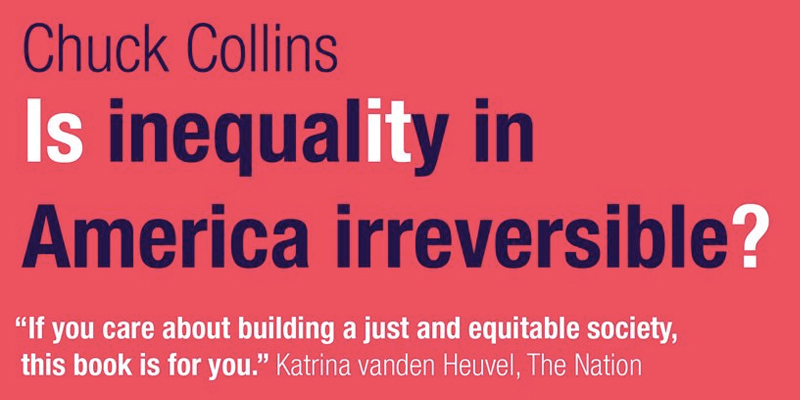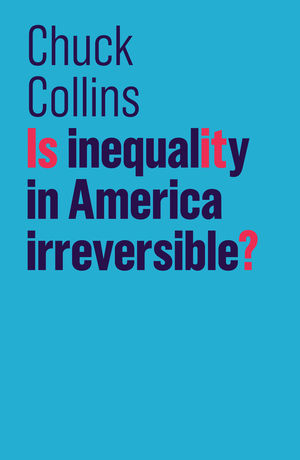Is Inequality in America Irreversible?
April 19, 2018

An excerpt from Chuck Collins’ new book, “Is Inequality in America Irreversible?”
A Front Row Seat to Inequality
I grew up in an affluent family in the wealthy Detroit suburb of Bloomfield Hills, Michigan. I attended an elite boy’s school, played tennis and golf at a private country club, and didn’t worry for much. Though growing up in the 1 percent, my parents had a strong sense of fairness and community responsibility.
At age 26, I had a job working with tenants in mobile home parks who were struggling to buy their mobile parks as cooperatives. In the process, I personally analyzed the private financial information of hundreds of low-income individuals in order to assess the feasibility of a resident-purchase.
By the mid-1980s, real wages for the bottom half of income earners in the population were starting to stagnate or decline. Because of my job, being privy to the financial secrets of many working-class and low-income Americans, I could see at first hand the impact of declining wages. I saw how people stretched and struggled to pay their bills, from working more hours, putting more family members into the paid labor force, and taking on debt.
Because of my advantaged upbringing, I was also witness to the wealth-creating-wealth phenomenon at the top end of the ladder. I personally saw the value of wealth given to me double over a five-year period. All around me people were celebrating their appreciating real estate and financial investment assets.
In the 1990s, when I started to read about inequality trends, these were not abstract numbers on a page. I could recall the faces and stories of people at both ends of the US economic experience.
We are living in a time of extreme and extraordinary inequality. There is now a genre of research looking at different dimensions of the income and wealth gap. This body of work chronicles the shapes and facets of inequality and its adverse impact on everything we care about. I myself have written a few of these books, and have documented this growing body of analysis from my perch as coeditor of the web portal, Inequality.org.
This slim volume will intentionally not linger on the problems caused by inequality, but instead will focus on the pathways to reversing these inequalities. This introduction will provide an overview of changes in income, assets, and the racial dimensions of economic inequality.
The primary focus of this analysis will be on the US economy and its particular systemic inequalities of income, wealth, power, and opportunity. While US inequality is part of a global trend, the condition is more acute due to the nature of hyperindividualistic capitalism and public policy in this country.
 Chapter One summarizes the interdisciplinary research on the ways these inequalities undermine our democracy, public health, social mobility, economic stability, and civic life. In each case, I will point readers to other research on why these inequalities matter. In order to prescribe the proper remedies to reverse these inequalities, we must properly diagnose the causes. The second part of Chapter 1 examines the drivers of these inequalities and the debates as to their relevance. This discussion will go beyond the simplistic theory that they are driven by technological change and globalization, though these forces have contributed to the gap. These inequalities have their roots in “rule changes” in the economy, the result of imbalances of power and agency.
Chapter One summarizes the interdisciplinary research on the ways these inequalities undermine our democracy, public health, social mobility, economic stability, and civic life. In each case, I will point readers to other research on why these inequalities matter. In order to prescribe the proper remedies to reverse these inequalities, we must properly diagnose the causes. The second part of Chapter 1 examines the drivers of these inequalities and the debates as to their relevance. This discussion will go beyond the simplistic theory that they are driven by technological change and globalization, though these forces have contributed to the gap. These inequalities have their roots in “rule changes” in the economy, the result of imbalances of power and agency.
Chapter 2 will confront the significant barriers we face in reversing inequality, both in terms of the growing oligarchic power of wealth and the powerful narratives that hold inequalities in place. We will look at the current political moment in the US and the possibilities for change, setting up a more detailed conversation, in Chapter 5, of transformative campaigns.
The bulk of the book, after Chapter 2, is focused on the remedies and interventions required to shift the current US trajectory toward deeper inequalities – and reverse them. This will draw from the US historical experience of reversing the staggering inequalities of the first Gilded Age that emerged between 1880 and 1915. I will also draw lessons from social democracies that operate in the same global capitalist framework as the US but have considerably less inequality.
For ecological reasons, however, we cannot simply repeat the same playbook from the past, such as the policies that created the post-World War Two period of shared prosperity. Ecological limits to growth will constrain our ability to reduce inequality with a revival of carbon extraction and burning. As we face the realities of climate change — and the breaching of other ecological planetary boundaries such as declining fresh water and soil fertility alongside ocean acidification — a program to reduce inequality will have to operate within the constraints of a finite planet.
The discussion of policy interventions to reverse inequality will utilize a framework suggested by sociologist S.M. Miller. He clusters policy solutions into three sometimes overlapping categories: raising the floor, leveling the playing field, and reducing concentrations of wealth and power. Chapter 3 will explore solutions that “raise the floor,” reducing inequality by means of a substantial safety net and by establishing an income and wage floor that enables workers to share in productivity gains. The chapter also examines solutions that “level the playing field,” ensuring equality of opportunity and eliminating distortions in rules that govern the economy and that preference one group over another. Chapter 4 will survey solutions that reduce the “concentration of wealth and power,” including taxing the wealthy and instituting anti-trust provisions in order to break up corporate monopolies.
The final chapter will consider approaches to overcome the considerable barriers in terms of power politics, societal narratives, and economic theories. We will examine four examples of transformative campaigns and strategies for disrupting narratives that justify inequality and shifting power relations to reverse inequality.
